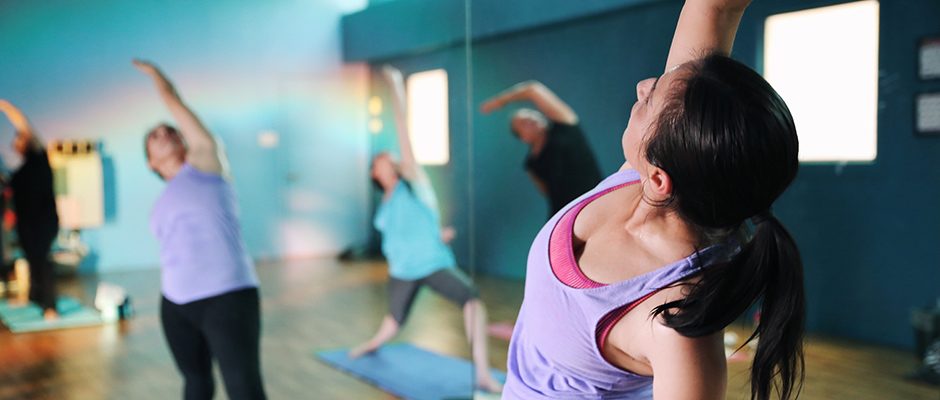

Square your hips. Tuck your tailbone. Zip your navel to your spine. Listening to your trainer is much like playing a game of “Simon Says.” But if you’re new to exercise or trying a workout for the first time, it’s not uncommon to get tangled up in a trainer’s cues.
Pete McCall, CSCS, ACE-certified personal trainer and host of the All About Fitness podcast, says, “Trainer cues are meant merely to create awareness to movement. They’re there to help people be more mindful of what they’re doing.” With that said, if you’re unsure about something, don’t be afraid to ask your trainer to clarify or explain. After all, these prompts are intended to help you get the most out of your workout and prevent injury. Read on to learn the most common trainer cues and how to decode them.
RELATED: The 15 Most Underrated Exercises, According to Trainers
What Your Trainer Really Means When They Say…
1. Tuck your tailbone.
Trainer translation: OK, so you can’t literally tuck away your tailbone. But this common barre phrase is meant to help you bring awareness to the midline of your body, McCall says. Tucking your tailbone means engaging your abs and scooping your hips so that they’re tilted slightly forward. This helps to straighten your spine. “When your spine is rounded or rotates the wrong way, it could be a potential risk of injury,” McCall says.
2. Lead with the hips.
Trainer translation: When squatting, you may have heard the cue to “avoid letting your knees go over your toes” or to “lead with the hips.” McCall explains, “What your trainer really means is that your hips should move before your knees when you perform a squat.” A strong squat starts with a hip hinge and shooting your butt back and down to activate your glutes. “Whether you squat or lunge, your glutes should be doing more of the work,” McCall says.
3. Feel a two-way stretch.
Trainer translation: Another common yoga and barre phrase, this cue simply means to lengthen, says Krystal Dwyer, Daily Burn 365 trainer and FlyBarre instructor. “Lengthen out of the top of your head and tailbone, or in some cases, out of your toes,” Dwyer says. “I want people to feel their entire body stretching and lengthening while they’re moving.”
4. Brace your core.
Trainer translation: Whether you’re performing a push-up or a plank, this cue is all about contracting your abs. “A more effective cue is to grip the floor with both hands. This gives you more stability in your shoulders and turns your abs on,” McCall says. McCall tells his clients to imagine their older brother punching their stomach. “You want to keep your entire core tight,” he says.
RELATED: 50 Ab Exercises to Score a Stronger Core
5. Pull your belly button towards the spine.
Trainer translation: This is impossible, obviously, but the point of this cue is to activate your transverse abdominis (TVA), the deepest layer of your abdominals. From a Pilates 100 to an ab roll-up, these waist-cinching moves are best known for engaging your TVA. “By activating your transverse abs, you’re firing up all four layers around your lumbar spine,” McCall says. “This helps keep your back stable and supports your hips and pelvis,” he adds.
6. Pinch your shoulder blades.
Trainer translation: Put some back into it! Imagine that there’s a ball between your shoulders on your upper back, and you don’t want that ball to drop. From renegade rows to reverse flies, scapular retraction will allow for better posture, muscle activation and injury prevention. “Pulling should come from the elbows. Pinching your shoulders keeps them out of the way so your arms can move safely,” McCall says.
RELATED: Get Sculpted Shoulders with These 5 Exercises
7. Draw your chin back.
Trainer translation: It’s all about alignment. Whether you’re doing a plank or a push-up, you want to make sure your entire body from the top of your head to your tailbone is aligned. “When we press our chin forward, we’re creating a lot of tension in our neck and upper back,” Dwyer says.
8. Pull up on the pedals.
Trainer translation: If you’re sprinting during spin class, McCall says it’s actually more effective to think about pulling up on pedals as opposed to pushing them down. Also, he adds, “Imagine wiping your shoe on a mat. This takes advantage of the natural motion of your foot muscles, so you move more efficiently and with more control.” Whether you’re sitting in a neutral on the bike or climbing in third position, this cue is also a good reminder to engage your glutes and hamstrings to pull the pedals away — and not just your quads.
RELATED: 7 SoulCycle Secrets for Proper Form on a Spin Bike
9. Open your heart.
Trainer translation: Your trainer isn’t trying to get deep into your psyche here. It simply means to keep your chest lifted and open. “Think of having a diamond necklace on and your showing it off,” Dwyer says. Hunching your back over a desk during the day makes your chest less open and more prone to shoulder injury while lifting. “Press your shoulder blades down into your back pocket and keep your chin lifted and back,” she says.
Read More:
Push Through Any Workout with These Trainer Mantras
The 25 Craziest Workout Excuses Trainers Have Ever Heard
Just Not Feeling It Today? 33 Sources of Workout Motivation
The post The 9 Most Common Trainer Cues, Decoded appeared first on Life by Daily Burn.
